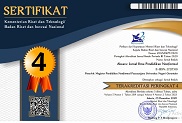The Effect Of Body Image Psycoeducation On Students
Abstract
Student body image is formed from attitudes and perceptions of characteristics in terms of physical or appearance. This study aims to determine whether there is an influence of psychoeducation on body image in students. This study used a quasi-experimental method with a pretest-posttest control group design. The instrument used is a body image questionnaire that has been developed with 9 statement items. The research subjects were students at one of the universities in Makassar, totaling 44 students consisting of 22 experimental groups and 22 control groups. The data analysis used in this study was the t-independent sample test. The results showed that there was no significant difference in body image scores when viewed from the two groups. However, based on independent sample t-test, it shows that the mean for the control group is 27.5 and the experimental group is 28.0, which means that the average value of the experimental group is higher than that of the control group.
Keywords
Full Text:
PDFReferences
Bartholomew LK, Parcel GS, Kok G, Gottlieb NH. Planning Health Promotion Programs
: An Intervention Mapping Approach. Second Eddie. San Francisco: Jossey-Bass;
Cash, T. F. &. Cash, D. W. (1982). Women's use of cosmetics: Psychosocial correlates
and consequences. International Journal of Cosmetic Science, 4, 1-13.
Cash TF, Lavallee DM. (1997). Cognitive-Behavioral Body-Image Therapy: Extended
Evidence of The Efficacy of a Self-Directed Program. J Ration - Emotive Cogn -
Behav Ther. 1997;15(4):281-94
Cash, T.F. (2000). Body image: A handbook of theory, research, and clinical. New York:
Guilford Publications.
Cash, T. F., & Pruzinsky, T. (2002). Body image: A Handbook of Theory, Research, and
Clinical Practice. In Technology Review (Vol. 108). https://doi.org/10.1007/978-0-
-79061-9_381
Chas, F. Thomas. (2004). Body Image, Development, Deviance, and Change. New York:
The Guilford Press
Ghahremani L, Hemmati N, Kaveh MH, Fararoei M. Effects of an educational
intervention targeting body image on self-esteem of Iranian high-school students:
A quasi-experimental trial. Arch Psychiatry Psychother. 2018;20(1):59-66.
Grogan, S. (2008). Body Image : Understanding body dissatifction in men, women and
childern (2nd ed.). New York: Routledge.
Handarini OI, Wulandari SS. (2020). Online Learning as a Study From Home (SFH)
Effort During the Covid 19 Pandemic. J Office Adm Educator. 2020;8(3):639-43.
Hartaji, D. A. (2012). Achievement motivation in students who study with the parent's
choice of major. Faculty of Psychology Gunadarma University.
Hurst, M., Dittmar, H., Banerjee, R., & Bond, R. (2017). “ I just feel so guilty â€: The role
of introjected regulation in linking appearance goals for exercise with women ' s
body image. Body Image, 20, 120-129. https://doi.org/10.1016/j.bodyim.2016.1
002
Hurlock, E. B. (1997). Developmental psychology a life span approach (ed. 5). Jakarta:
Erlangga.
Irawan, S. D. (2014). The relationship between body image and dietary behavior of Esa
Unggul female students. Journal of Psychology, 12(1), 21-23.
Lionita, Widya., Arinda, Ditia Fitri., & Appulembang, Yeni Anna., Anggraini,
Rini.(2021). ILMe (I Love Me): Psychoeducation on Body Image Perception for
High School Students. Indonesian Journal of Health Promotion Vol 16 / No. 1 /
January 2021
Maulida, Amalia., Ovie, Nita., Mega, Silviani Putri. (2015). Sports therapy to increase
self-confidence for people with not ideal body weight 1). Mulawarman
Psychostudia Journal, 4(2).
Muhith, A. (2015). Psychiatric nursing education theory and application. Jakarta:
Publisher Andi.
Mwaba, K., & Roman, N. V. (2009). Body Image Satisfaction Among a Sample of Black
Female South African Students. Social Behavior and Personality: An International
Journal, 37(7), 905-910. https://doi.org/10.2224/sbp.2009.37.7. 905
Pop, C. (2016). Self-esteem and Body Image Perception in a Sample of University
Students. Eurasian Journal of Educational Research, (64), 31-44.
https://doi.org/10.14689/ejer.2016.64.2
Prima, E., & Sari, E. P. (2013). The relationship between body dissatisfaction with dietary
behavior tendencies in adolescent girls. Journal of Integrative Psychology, 1(1).
Reel J, Voelker D, Greenleaf C. Weight status and body image perceptions in adolescents:
current perspectives. Adolescent Health Med Ther. 2015;149.
Santrock, J.W. (2012). Life span development. Jakarta: Erlangga Publisher.
Setiawan, Benny W. (2020). The Relationship between Body Image and Early Adolescent
Self Confidence. Semarang: Faculty of Psychology, University of Semarang
Surya, H. (2009). Become a learning person. Jakarta: Elex Media Komputindo.
Srivastava P, Panday R. Psychoeducation an Effective Tool as Treatment Modality in
Mental Health. Int J Indian Psychol. 2016;4(1):123-30.
Sugiyono. (2010). Research methods are quantitative, qualitative, and R & D. Bandung:
Alphabeta.
Thompson, J. & Smolak, L. (2002). Body image: Eating disorder and obesity in youth.
Washington DC: WHAT.
Yusuf, S. (2012). Developmental psychology of children and adolescents. Bandung:
Rosdakarya Youth..
DOI: http://dx.doi.org/10.37905/aksara.8.2.1023-1030.2022
Refbacks
- There are currently no refbacks.
Copyright (c) 2022 Aksara: Jurnal Ilmu Pendidikan Nonformal

This work is licensed under a Creative Commons Attribution-ShareAlike 4.0 International License.
Publisher:
Magister Pendidikan Nonformal Pascasarjana Universitas Negeri Gorontalo
Jl. Soedirman No. 06 Gorontalo 96128 e-mail: jurnalaksara@ung.ac.id
http://ejurnal.pps.ung.ac.id







